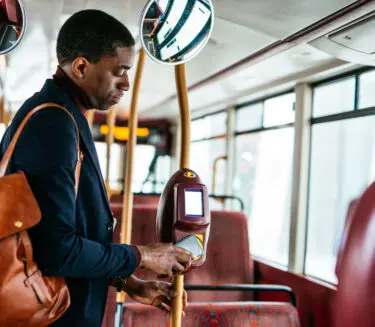As we return to some of our pre-pandemic habits and routines, cities across Canada and around the world will devise ways to get their populations moving again.
Throughout the pandemic, public transit ridership has taken a nosedive in cities from coast to coast. In Vancouver, TransLink reported an 83 per cent decrease, for example, while the GO Transit service that serves Southern Ontario lost 90 per cent of its riders.
Operators still face a number of unknowns, including potential changes in ridership patterns and uncertainty over whether demand will rebound to something like pre-pandemic levels. Experts and academics who study cities and transit have speculated that it could be years before commuters come back — and, due to the ongoing viability of the home office, it’s possible some never will.
Could modernized fare systems for transit play a part in making everyone, including passengers, comfortable and safe again? Payment modernization offers transit systems potential benefits and use cases that could be more relevant and important than ever.
Here are a few of the options that digital payments can unlock for transit systems in Canadian cities.
Promote physical distancing
Even as the pandemic subsides, some experts believe many people will want to maintain the habits of physical distancing. This poses a challenge for transit systems: How to balance the imperative to collect fares against the responsibility to safeguard passenger health and safety.
In general, digital fare systems can reduce close physical proximity and contact between staff members and passengers, by virtue of the fact that digital payment media often don’t have to be passed by hand. This is a benefit of both open payment systems — which allow customers to pay to board using their existing cards issued by financial institutions, or digital wallets that have those cards added — and closed-loop payment systems, in which transit authorities issue dedicated fare media such as cards and tickets.
Facilitate all-door/rear-door boarding
A number of cities across Canada implemented rear- or all-door boarding of transit vehicles during the pandemic. This promotes physical distancing, and it also facilitates faster boarding — which is why Toronto’s TTC implemented it on its streetcar system several years before COVID-19.
Some cities also suspended fare collection altogether for certain portions of the pandemic, in part because their analogue systems — involving collection of physical fares and inspection of tickets and passes — couldn’t be reconciled with physical distancing. In Saint John, New Brunswick, for example, the city’s transit agency decided to stop collecting fares because the collection boxes are positioned directly next to its bus drivers’ seats.
In Toronto, by contrast, all-door boarding (already in place in the streetcar system) was introduced in buses as well during the pandemic. Like in some other cities, passengers can use their fare cards to pay at terminals positioned near the doors.
Reduce and eliminate lineups
Open payment systems, which typically enable customers to use their existing bank cards and mobile wallets to ride, allow most passengers to pay without ever having to queue at a kiosk. These passengers could then circulate through stops and stations faster, and thus avoid forming crowds.
When open payments were introduced in London, England, commuters with compatible payment cards already in their wallets (for example, cards issued by their banks) no longer had to wait in line to buy fare media. Transport for London noted the resulting reduction of crowds as a benefit of open-payment systems.
Provide a convenient way to give discounts to selected residents
The COVID-19 pandemic isn’t just a public health emergency, it’s a time of financial crisis for many Canadians as well. In response, governments have created relief programs for those affected.
If local and regional governments want to further assist people by helping them get from place to place, they can potentially use digital systems to do that, as they can be topped up remotely, and they can contain information about discounts.
What does that mean in terms of assistance programs? It means transit authorities could theoretically help entire categories of transit riders with the push of a button.
In the San Francisco Bay Area, for example, holders of the local RTC Clipper Card who can demonstrate a low household income are entitled to steep discounts of 20 to 50 per cent on local transit systems through a program called Clipper Start.
Accommodate occasional users
Open-loop payment systems can allow passengers who are spontaneous or occasional users to board a vehicle more easily and without planning ahead (because they can use their existing cards and mobile wallets rather than tickets or passes specific to the transit system).
That reduces the level of commitment to try riding transit again — and lowers the barrier for any commuters who might be on the fence about returning.
Enable multi-modal transport and microtransit
Even before the pandemic, transit experts noted commuters’ growing interest in using public transit options that involve non-traditional means of getting around, such as shared bicycles and ride-share services.
This article talks about how open payments can facilitate so-called “multi-modal transport,” creating seamless transportation experiences that suit individual commuters’ preferences and needs. A related term is “microtransit”; it’s used for small-scale services that offer fixed schedules or on-demand transportation on a small scale (typically involving local commuter shuttles, or partnerships with private ride-share services).
As cities and transit systems across Canada explore these possibilities, they’re also grappling with the fact that the COVID-19 pandemic dealt them a once-in-a-lifetime challenge. While solutions for rebuilding transit ridership will require a multi-pronged approach, payment technology has the potential to help support this effort while providing people with a more convenient user experience along the way.
_____
*Payment options depicted are intended to show examples of what the future of modernized transit payments could look like, and do not reflect products actually available in market.*
Interac is a registered trade-mark and the Interac logo is a trade-mark of Interac Corp.
The Contactless Indicator mark, consisting of four graduating arcs, is a trademark owned by and used with permission of EMVCo, LLC.





